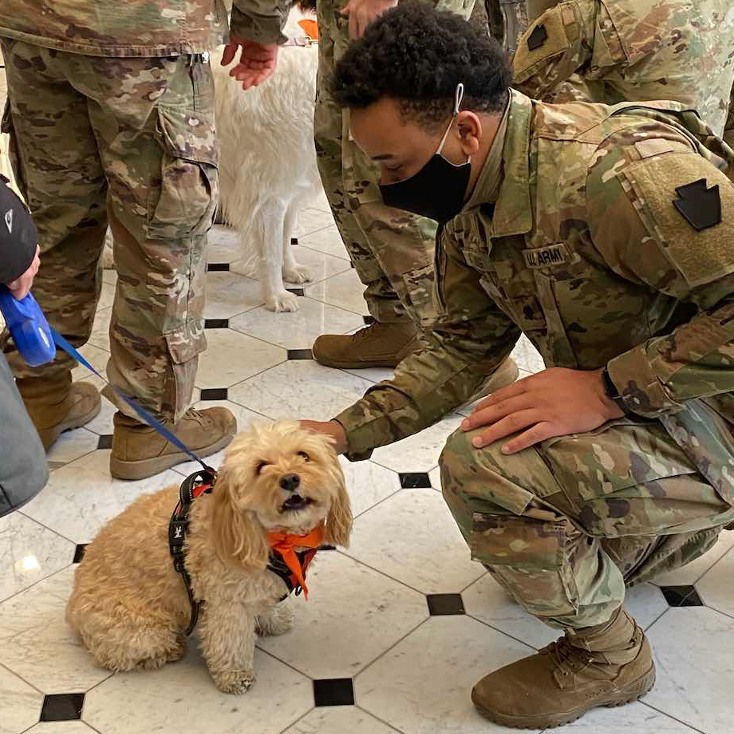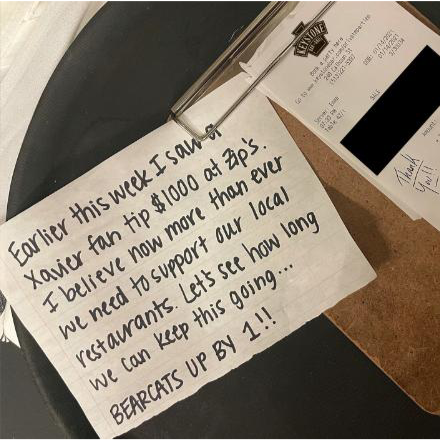Author: Kelly Brant
- A Man’s Best Friend
- Brian Myers, a resident of Teaneck, New Jersey, adopted his furry best friend a few months ago. Sadie, a six year old German Shepherd, was placed in the Ramapo-Bergen Animal Refuge after her family moved to a new property that did not allow dogs. She and Myers became best friends from the start. From the start, they have slept together every night and Sadie follows Myers everywhere. Their bond only grew stronger after Myers caught COVID. As a gentle giant, Sadie was there to keep him company and give him plenty of snuggles. More recently, at the end of January, Myers suffered a stroke. After he collapsed on the floor, Sadie jumped to action. She licked his face incessantly until Meyer’s woke up. According to Meyers, he grabbed her collar in an attempt to use her as a counterweight and stand back up. When Sadie saw that Meyers was unable to rise to his feet, she then dragged him towards his cell phone, so he could call for help. Thanks to Sadie, he was able to call an ambulance. Meyers was taken to a local hospital and later recovered at Kessler Institute for Rehabilitation. Meyers said to NBC New York, “I don’t know how she knew to do it, but that she was able to pull me the way she did, I was so grateful to her. I live alone, so if she hadn’t come and did what she did, I may as well have been worse off than I am right now.” NBC captured the reunion between Sadie and Myers after he was released from the hospital. Ramapo-Bergen Animal Refuge reposted the reunion video and is now raising money to pay for Sadie’s food and vet appointments, as Meyers has to leave his job while he recovers. Sadie looks eager and excited while Myers is tearful and very grateful. When asked about adoption, Meyers stated, “There are many other dogs there waiting to be somebody’s hero.”
- The Empire State Building is now fully powered by wind
- The beloved Midtown Manhattan landmark has been a quintessential piece of New York City architecture and tourism since its completion in early 1930. Now, the building is becoming much more environmentally friendly. Empire State Realty Trust (ESRT), the company that owns this skyscraper and 13 other office buildings, signed a three-year deal with Green Mountain Energy to power its entire portfolio with renewable wind electricity. According to the EPA, this makes ESRT the country’s largest 100% user of green power. Green Mountain Energy first began supplying energy to the Empire State Building in 2011. The company was awarded the contract after an extensive bidding process and is expected to save ESRT more than $800,000 in electricity costs within the first year of the contract. “We have purchased renewable power from Green Mountain Energy for the Empire State Building, for a decade,” said Dana Robbins Schneider, director of energy at ESRT. “We now expand that to all properties in New York State with an additional direct energy contract for our Connecticut properties. Our tenants now work in carbon neutral offices.” ESRT controls over 10.1 million square feet of real estate, all of which will run on renewable energy for at least the next three years. According to a press release, this transition to wind power will result in a savings of 450 million pounds of carbon dioxide. This is roughly the equivalent to the savings if every New York State household turned off all of their lights for a month, or if all New York City taxis were off the street for a year. The Empire State Building has endured renovations over the last 10 years as part of the $550 million restoration program, reducing its carbon footprint by 40%. The building announced last year that everything from its elevators to its windows had been updated to align with their sustainability commitment.
- “Here’s Booking at You, Kid!”
- After returning from her first day of kindergarten, Selah told her father that many of her classmates did not know their ABCs. Selah, a lover of books, was saddened that her classmates were unaware of the joys of reading. After doing some research, Selah’s parents learned that literacy is much more than just being able to read. Rather, it is a market of future success. According to Literacy Inc, 85% of minors in the juvenile prison system are illiterate. Further, two-thirds of students who cannot read proficiently by the end of fourth grade will end up in jail or on welfare. According to Selah’s father, Khalil Thompson, “some prisons forecast the number of prison cells they are going to build in the future based off of third grade reading test scores.” The Thompson family decided to take on systemic illiteracy and its negative impacts. In 2018, with her parent’s help, Selah launched her own nonprofit, the Empowered Readers Literacy Project. Its goals are to help families build strong reading rituals and spark an enthusiasm around books. Selah and her parent’s organization has seen immediate success. At their first official event, which took place in Atlanta on Martin Luther King Jr. Day in January 2018, 2,400 kids and their parents participated in the march for literacy. In addition to activism, the Empowered Readers Literacy Project runs an adventure time readers club. They also have an initiative called the 500 books project, a book drive dedicated to providing children with books. Further, Selah and her family realized another possible barrier to learning to read. In addition to elevating reading frequency, exposure to characters that children identify with is also essential. Selah’s mother, Nicole Thomspon, stated, “Children are not excited about reading when they do not see themselves on the pages of the book.” There needs to be more diverse representation in children’s books. Accordingly, Selah and her younger sister Syrai published “Penelope the Pirate Princess'' in 2019. Penelope looks like Selah and shares a love for science and outer space. Inspired by the COVID-19 pandemic, Selah published the second book in the series this past December titled “Penelope the Pirate Princess: A Bad Case of Glitter Spot Dots.” When speaking about the book, Selah articulated, “Covid is like glitter, It spreads everywhere, and it doesn’t stop.” Just like glitter, this little girl’s intelligence and compassion sparkles. To date, Empowered Readers Literacy Project has donated 8,000 books, including the books authored by Selah and her sister. Selah is well on her way to achieving her goal of donating 2 million books. Along the way, she is doing much more than spreading a love of reading. She is inspiring us all, young and old, to see the importance of representation and diversity on children’s empowerment. Further, she is showcasing that if an 8-year-old can commit to making positive change in this world, so can we.
- Therapy Dogs Visit National Guard Troops Stationed in D.C. Who Are Missing Their Own Pets
- Following the attack on the Capitol, thousands of National Guard Troops found themselves stationed in Washington D.C. for the foreseeable future. With many stationed far from home, their families, and even their pets, these servicemen no doubt have been feeling slightly homesick. Just in time for Valentine’s Day, the Hamilton Hotel, where more than 250 Guardsmen have been staying while deployed, arranged for their guests to be surprised with a dozen therapy dogs. This was an amazing gesture of thanks on behalf of the hotel to a group of individuals who have shown incredible dedication through their round-the-clock service to our country. And, from the pictures, it seems that it was just what the Guardsmen needed in this time of uncertainty. Therapy dogs have been an important part of helping many get through this COVID-19 pandemic. 2020 saw record high adoptions, with many looking to get ‘therapy dogs’ of their own. And, for those who couldn’t adopt, utilizing others registered therapy dogs has been a great alternative. Even over zoom, therapy dogs have continued to put smiles on people’s faces. Some dogs have even started acting as virtual reading partners for young children. The 12 dogs who visited the Hamilton Hotel work with their owners through a non-profit called People Animals Love. For an hour, they stood at various spots around the hotel lobby, eagerly waiting to receive pets from the next Guardsman who knelt down next to them. The joy on Guardsmen’s faces from this spontaneous visit was clear, even behind their masks. “Seeing hardened military men and women, roll around on the ground with these amazing dogs, as if no one is watching, truly filled our souls with happiness and gratitude,” Hamilton Hotel director Joe Palminteri told GNN. “It was only an hour, but the smiles and warm embraces will last a lifetime.”
- 220 million-year-old dinosaur footprint discovered by 4-year-old in Wales
- Lily and her father were walking along Barry Beach in Wales, when the four-year-old excitedly pointed out a 4-inch reptilian-looking imprint on one of the coastal rocks. When Lily returned home with pictures of the mysterious imprint, her grandmother suggested that they reach out to local experts about her finding. They soon learned that Lily had discovered a 220-million-year-old fossilized dinosaur footprint, which had been preserved in mud. Cindy Howells, the paleontology curator at the National Museum of Wales, told BBC that the extraordinarily detailed imprint was “the best specimen ever found on this beach.” According to NBC, the preserved footprint has been safely extracted and will soon be moved to the National Museum of Cardiff, where Lily’s name will be displayed as the “finder” of the artifact. Lily’s mother, Sally, said "We're going to keep encouraging exploring outside…It's great as it gets them really interested and the whole family can learn together." Barry Beach is located in Bendricks Bay and is an important site for paleontologists and special scientific research. Lily’s discovery has helped give scientists new insight into the muscles and joints of the prehistoric creature, which scientists estimate to have been about 30 inches tall and 8.2 feet long, according to Livescience. Similar footprints have only been found in the United States. In a statement from the National Museum of Wales, this remarkable discovery and impeccable preservation “may help scientists establish more about the actual structure of their feet as the preservation is clear enough to show the individual pads and even claw impressions.”
- Researchers Have Found a Way For Spinach To Send Us Emails, And It Could Help Solve Climate Change
- You read that right – scientists are now in communication with spinach. Yes, the leafy green plant that so many children struggle to stomach has recently been gifted the ability to send emails, but maybe not in the way you would expect. MIT researchers have engineered the roots of spinach plants to contain nanosensors, capable of detecting explosives and man-man chemicals. When detected, these sensors send a signal to an infrared camera that then shoots out an email alert. Ok, so maybe spinach isn’t sending emails asking about our day, but this ability to utilize the natural sensitivity of plants to detect harmful compounds is an incredible step towards a more informed world. Breaking this “plant/human” communication barrier is one way scientists might actually be able to track and attempt to mitigate climate change. “Plants are very good analytical chemists,” explains Professor Michael Strano, who led the research, in a statement to EuroNews. “They have an extensive root network in the soil, are constantly sampling groundwater, and have a way to self-power the transport of that water up into the leaves.” Plants are capable of knowing environmental changes much earlier than humans. They can predict if there is going to be a drought and, even more amazingly, can detect even the smallest changes in soil or water properties. Being able to harness this ability and have plants send alerts about potentially dangerous changes might give us an edge over drastic climate changes before they occur. So, even though spinach might not be emailing us in the way we would expect, this plant is working to bring us one step closer to a healthier world.
- Snowy Owl Sighted in Central Park for the First Time in Over a Century
- While on daytrip to the Rockefeller State Park Reserve, bird-watcher Becky DePorte received a text from a friend – a picture of a snowy owl in the middle of Central Park. 45 minutes later, DePorte found herself back in Manhattan – along with other, fellow birders – snapping pictures of the creature that have since gone viral. At the time, DePorte was unaware of the fact that this was the first sighting of a snowy owl in Central Park in 130 years; or that this was likely the first time the owl had been photographed in Manhattan. Snowy owls have been spotted every year around the Northern Lakes and the Northeast during the winter months. There are years, however, where a big irruption event causes a larger number of birds to migrate down from the Artic, which allows for more sightings in a wider range of places. Some of the rarest Snowy Owl sightings have occurred in Bermuda and Florida of all places. Scott Weidensaul, who co-founded Project SNOWstorm to track snowy owls and study their movements explained that he wouldn’t be surprised if another snowy owl had been in Central Park in between the documented 1890 spotting and January 27th. In a statement to the USA Today, Weidensaul explained that, "The surprising thing about this one is that [the owl] ended up in Central Park in the day for long enough for someone to spot it." Many have wondered when and if they might be able to spot the allusive owl again in the city. Unfortunately, there is no clear answer. Researchers say that it is just as likely that another snowy owl appears in Manhattan today as it is that another sighting occurs 130 years from now – this species is just really unpredictable. Though likely just a fluke occurrence, the owls brief visit has given city dwellers a reason to smile amid this pandemic-winter, with many hoping to catch glimpse of this allusive creature sometime in the not-so-distant future.
- Michael Jordan is Making (Food) Baskets
- Jordan’s $2 million donation represents a significant portion of the profits he has amassed from his docuseries, “The Last Dance.” His large gift to Feeding America will help local food banks in North Carolina, South Carolina, and Chicago. Feeding America is a nonprofit organization responsible for operating more than 200 food banks. They currently serve 46 million Americans. According to the charity, 1 in 9 people struggle with hunger in the United States. The numbers of those facing food insecurity continue to rise as unemployment rates spike upward in the face of the pandemic. Invoking Feeding America’s $1=10 meals promise, the NBA legend will be responsible for providing 20 million meals. With his generosity and empathy, Jordan reminds us all of the importance of giving back. In the statement announcing his huge donation, Jordan also stated, “In these challenging times and in a year of unimaginable difficulty due to Covid-19, it’s more important than ever to pause and give thanks." Feeding America was especially appreciative and grateful, tweeting, “An incredible gift to be thankful for- NBA legend Michael Jordan is donating $2 million to help our neighbors facing hunger! #TheLastDance. Every action makes a difference. Join Michael & visit FeedingAmerica.org/COVID19 to learn how you can donate or volunteer this holiday season. While we might not all have the funds to finance Feeding America monetarily, there are other ways to donate, whether it be time, ideas, or event planning. Jordan’s philanthropic pursuits did not begin in 2020 and likely will continue for years to come. His charitable activities are especially significant in the areas of Chicago, Illinois, and Charlotte, North Carolina. Ranging from donations to hospitals and clinics, the Special Olympics, the NAACP, and Youth Programs, Jordan’s goal is clear: do good. Most recently, he pledged to donate $100 million over the next ten years to organizations dedicated to fighting for racial equality. He is using his wealth and influence to make the world a better place. While he will always be known for the baskets he’s made, his legacy survives among those whom he has given aid.
- The Great Cincinnati Tip-Off
- In a warmup of sorts for March Madness, a different type of tip-off is occurring between University of Cincinnati and Xavier University. Just a few miles apart, these two institutions share the same city. There is a competitive rivalry that brews between their sports teams and respective fans. The rivalry is spreading to the streets, but this time, it is all in good nature. Fans and alumni of University of Cincinnati and Xavier University are in a tipping war- a competition to see who can leave the biggest tip at local restaurants in Cincinnati. It all started at Zip’s Cafe in January, when a former Xavier student left a $1,000 tip on his $54 bill. He wrote on an accompanying note to his fellow Xavier alumni server, “Please share this tip with all of your employees as they work so hard and are dealing with COVID. Go Xavier!” After Zip’s Cafe posted this act of kindness on their social media, University of Cincinnati fans got bit by the competition bug. Six miles away from Zip’s Cafe at Keystone Bar and Grill, two Cincinnati fans left a $1,0001 tip and a note that read, “Earlier this week I saw a Xavier fan tip $1,000 at Zip’s...I believe now more than ever we need to support our local restaurants. Let’s see how long we can keep this going...Bearcats up by 1!!” The bar posted a photo of the tip with the caption, “It’s your turn, Xavier fans! Who will be one-upping the Bearcats by leaving a $1,002 tip at your favorite local bar or restaurant?” The tip war keeps going. The Birch, a wine bar in Terrace Park, recently received a $4,525 tip on a $54.98 bill. According to the Cincinnati Enquirer, the tip was crowd-funded by 90 local Xavier fans. In their last basketball matchup, the Xavier Musketeers beat the Cincinnati Bearcats 77-69. Bearcats are trying to redeem themselves by upping their tipping numbers. According to FOX19, Bearcats: $20,400 and Musketeers: $12,644. Regardless of the team tallies, a total of $33,044 has been given to restaurants, a sector hit especially hard by the pandemic. Around 110,000 American restaurants are either permanently closed or facing long-term closures. This money means a lot both financially and symbolically. It is helping these struggling businesses stay open while also showing owners and staff that they have the support and compassion of their community.








